Moog Mother-32 Review
The Mother-32 is the much-anticipated first foray into Eurorack from the giants of modular. Dave Gale wonders if this tiny package measures up…
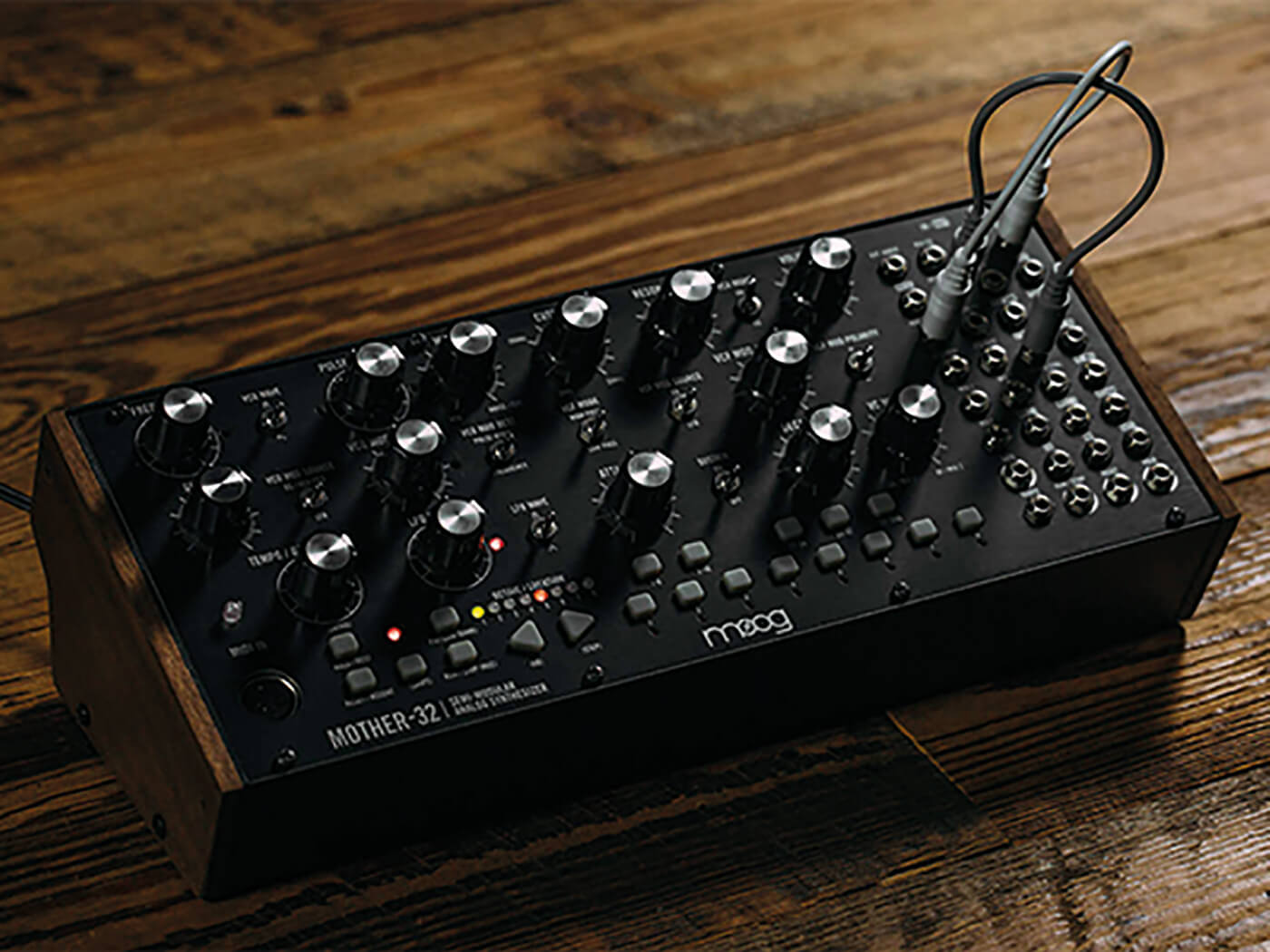

Price £499
Web www.moogmusic.com
Many have been wondering when Moog would enter the Eurorack market, as most of us synth-heads have had to make do with drooling over reincarnations of the huge modulars shown at last year’s NAMM Show. Well here’s the good news – it’s pint sized, it packs a huge, weighty punch and it has an incredibly affordable price tag.
Unmistakably Moog
To say I was looking forward to getting my hands on this is an understatement, and upon removing it from the box, I was delighted to see Moog has taken its usual care and attention, packaging it in an ergonomic case with wooden end cheeks, which at 60 HP is just right for the Mother-32.
Once powered up by the included DC power supply, the VCA was increased to reveal the glory of the Moog oscillator, generating a saw tooth by default, and then came the filter! Now I can’t overstate the importance of both of these factors here; there is a reason why Moog has the reputation that it does, and it starts with the oscillator, and leads to the filter.
Both of these elements together create the richest, smoothest tone that can be heard on a subtractive synthesiser. At this point, all I could do was continually open and close the filter, and keep pinching myself to be reminded that it’s a Moog for under £500, which will also go in my Eurorack!
Having managed to curtail my teenage excitement, I then began to explore the subtractive architecture of this device. The single oscillator generates both saw and pulse (square) waveforms, but by default, the Oscillator Mix control, which blends together two timbre sources, offers saw and white noise; the latter being semi-hard wired, but it can be overridden via the patch bay, as there is an external input at this stage.
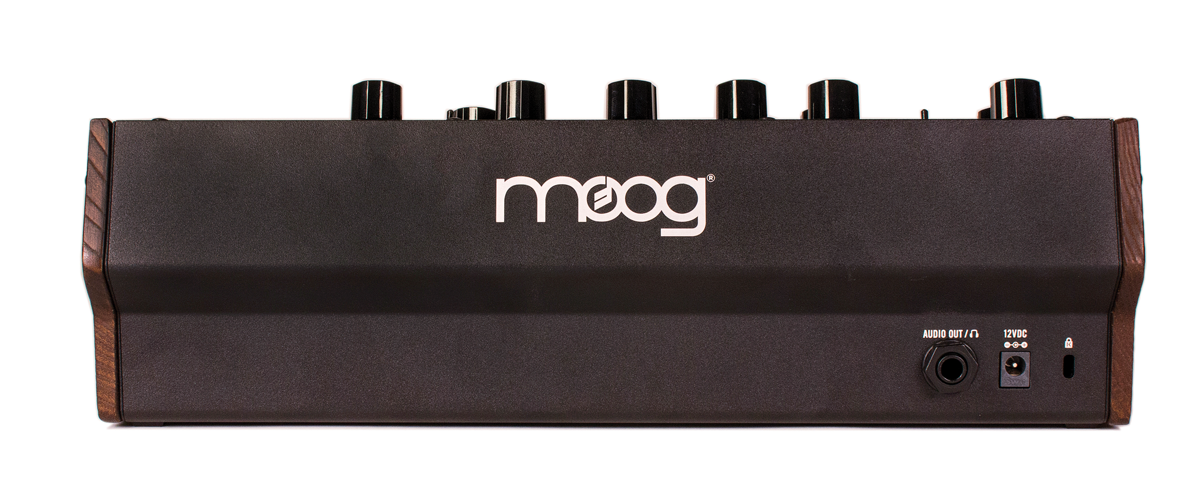
Now was the time to reach for the little packet of five mini-jack cables, included with the Mother, that enable the user to get their hands dirty with the patch field.
Taking the VCO Pulse output and patching it into the external Input, the white noise disappeared and was replaced by a rich pulse/square. In my next moment of teenage excitement, I reached for the Pulse Width Modulation and cranked it – it’s wild!
There is so much headroom here that the pulse could be rendered inaudible, and against the saw, this was heaven in an oscillator. Now at this point, I have to state that it would have been really nice if the pulse/square could have been dropped an octave or two, to have it act as a sub-oscillator. But then at this price,
I think Moog is offering a modular for the masses, with enticing racks to stack up two or three mothers in one unit (see boxout below). So if you want a sub, buy another Mother!
Turning our attentions to the filter, this is a classic Moog four-pole transistor ladder filter, with a switchable setting for low-pass and high-pass operation. As previously stated, it does sound wonderful, and it will go into self oscillation if the resonance is cranked.
I’ve heard through the grapevine that Moog has noodled with the circuit, to try and limit some of the low end dropping out as the resonance is cranked. Certainly, there seems to be some success here, but there is still a noticeable drop. The filter is also assignable to the single envelope or the LFO, via an amount pot.
Talking of the envelope, this is a single AD or ASD affair, in keeping with Moogs of old. It’s nice and snappy, or subtle, according to taste. The LFO is basic, with only square and triangle waves, but it does nicely extend up into the audio spectrum, and will even track to CV, albeit slightly crudely in my experimentations.
In doing so, one could argue that a third oscillator is available here; although, again in my experience, the main point of exploitation here would appear to be for distortion-type effects, which were wonderfully harsh and aggressive – which makes up for the lack of overdrive in the filter circuit we’ve seen on other Moog machines.
The numerous switches allow for easy routing right from the front panel, but it has to be said that the main event, at least in terms of routing, is the comprehensive patchbay. Thanks to the included mini-jack cables, you can jump right in and start patching. Nicely labelled and laid out, it is very obvious which patch points are ‘Ins’ and which are ‘Outs’, which is not something that can be said of some of the other Eurorack modules on the market.
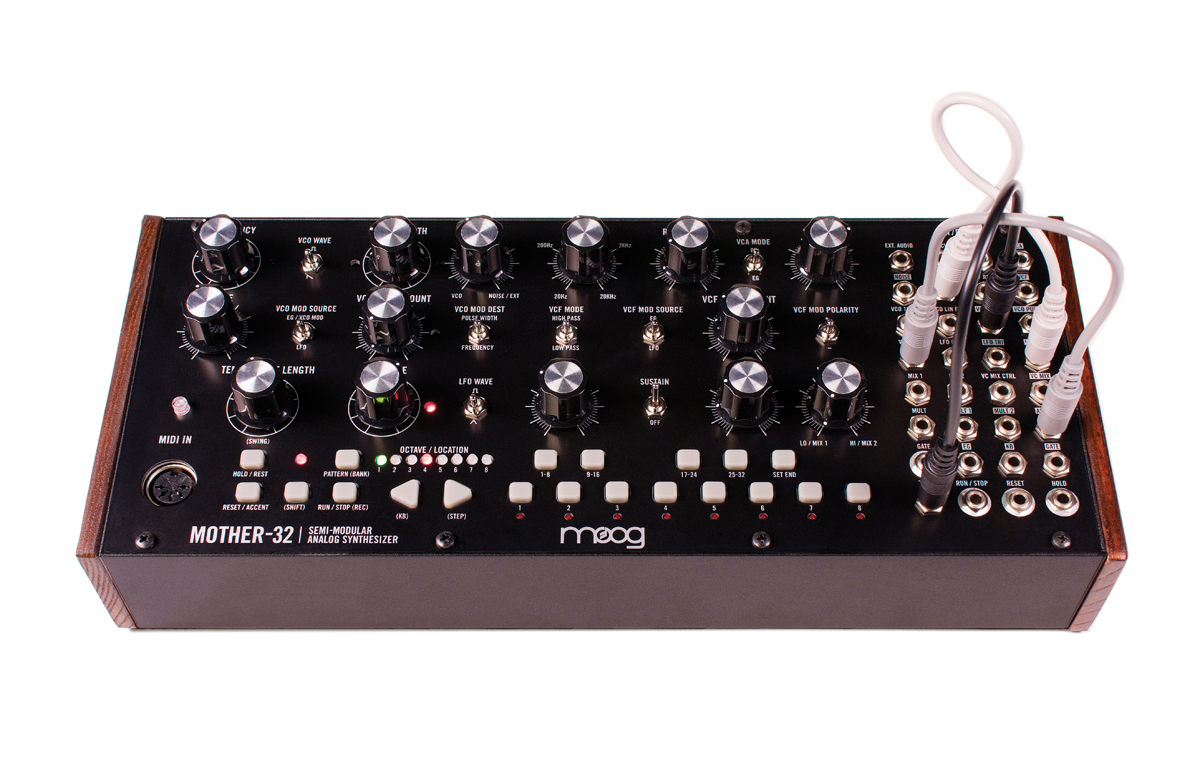
Much of the Mother 32 is available to CV control and, apart from the reasonably obvious connections, there are one or two which require a second look, for good reason. There is a handy ‘Multiple’ section, which will happily split a CV in two directions.
Always handy to have a splitter available; and in a similar reverse to this, there is also a VC Mix section, that will allow the summing of two CVs, which can not only be outputted directly, but mixed with a degree of fluidity using the VC Mix pot on the front panel.
Incredibly useful once again, and very comprehensive in something so small!
Finally, there is an ‘assignable output’ which will allow up to 16 different options, which are programmed by the user. These include clock outputs, that can be divided, stepped waveforms which work in conjunction with the sequencer, and even elements of accent and MIDI CC control. It’s all very comprehensive stuff, although just having a clock divider is a huge boon in itself.
To sum up the synth section: this is an incredibly flexible and tasty little package which, although lacking in elements such as a sub-oscillator, more than makes up for itself in the realms of patching capability. I can’t think of another Eurorack Synth Voice channel which takes this to such a degree, with such flexibility, and remains so easy to understand, right out of the box.
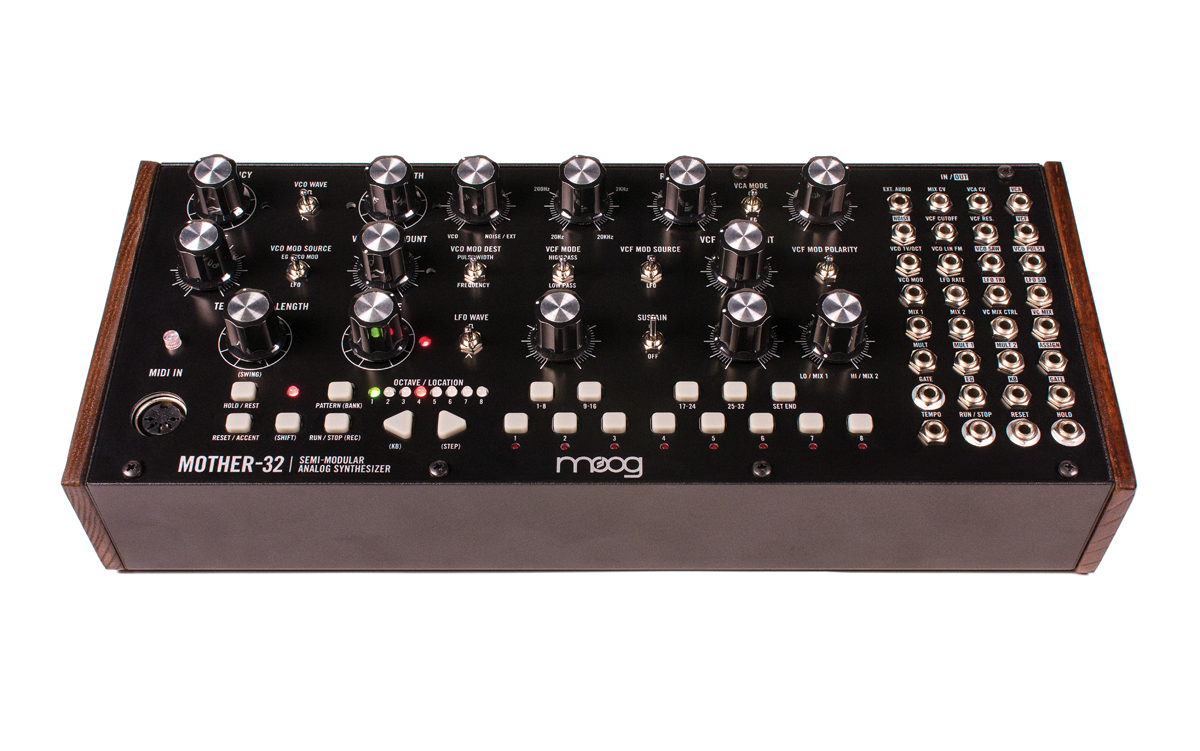
Mother 32… or 2 or 3?
There is absolutely no doubt that this is an ideal synth for a beginner to take their first tentative steps into Eurorack, and Moog has enticingly made a range of accessories to help enable you to use two or three Mothers, side by side (well, stacked, actually!) The two available racks will allow the mounting of units to create a semi-modular synth, with huge possibilities, and to say it looks cool (as well as sounding awesome) is the understatement of the century…
Alternatives
We are in the middle of a Eurorack explosion with many Synth Voice channels appearing at NAMM 2016. Currently, the Roland System 1M is worth considering, and it won’t be long brefore offerings from Studio Electronics, Pittsburgh Modular and Oberheim will offer similar units. Which is best? Well none, to be honest!
They are all looking pretty great, but they will all sound just a shade different, so your consideration should start with what sort of oscillator and filter you might like, and go from there. The Moog does, however, have a sequencer inbuilt, and that’s a very useful thing indeed.
Onboard Sequencing
Just when you thought that this little bundle of joy could have no more to offer, the finest of elements awaits at the bottom of the unit. A collection of little buttons, which are laid out like a keyboard, not only allow you to play the synth directly from the panel, but you also have a fully implemented 32-step, 64-pattern sequencer available.
Programming the sequencer is somewhat of a breeze, although it is just a step sequencer and will not record in any real-time capacity. It’s also comprehensive, allowing for accents, glides and even a great feature which Moog calls ‘Ratchet’, which adds a fashionable ‘stutter’ effect, but in a very analogue manner. It’s not harsh, like some I’ve heard, but musical – and in keeping with the spirit of this unit.
I found myself adding this on the fly, as a real-time control, just as I needed it, and in keeping with the idea of a living, breathing instrument.
At this stage, I do have to say that beyond pattern programming, the sequencer section is a little on the ‘multiple keypress’-heavy side, so much so that I found myself continually having to reach for the manual to remind myself how to perform certain aspects.
Even something as simple as saving a pattern isn’t so obvious, as the user is reliant on watching the eight LEDs which indicate various matters, according to location and flashing colour. However, despite this minor gripe, you’re likely to find yourself forgetting this point very quickly as soon as you hit the play button, especially as sequences can be transposed at the drop of a hat by pressing notes of the scale on the Mother’s little keyboard.
Of course, having the sequencer to hand immediately means that you can send CVs and gates to the other units in your Eurorack, or to your other Mother-32s, and so the fun and games continue on (and then the next thing you know, it’s 3am).
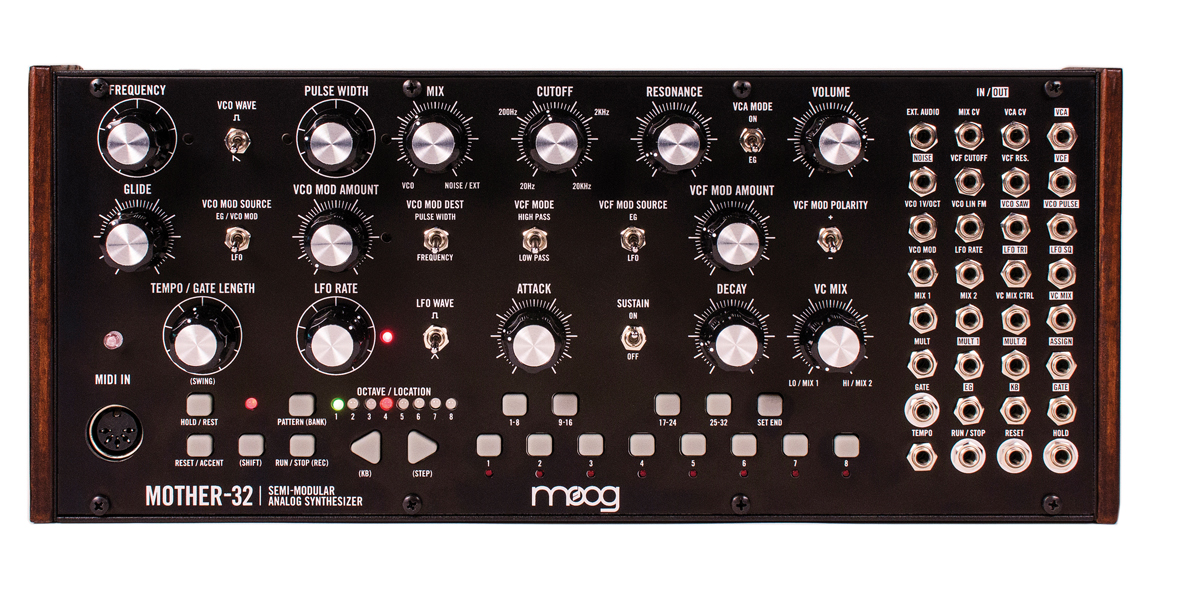
Rack it Up, Or Standalone
Like many of the current batch of Eurorack synth-channel voices that are creeping onto the market, this unit can be used in a number of settings. Unlike some other brands, Moog has taken the care to place the Mother-32 in a lovely little 60 HP Eurorack box, which allows power from the included DC power supply, as well as Headphone and Audio output.
If, like me, you have a Eurorack and want to incorporate it into this, being of Euro size will mean that it will easily slot into an existing Eurorack enclosure.
Be aware that if you want to power it from within your modular, you will need to buy an additional 10- to 16-pin cable, to allow connection to your distribution board. It’s a shame this wasn’t included, but I imagine Moog is guessing many users will want to leave it in the supplied case. I can’t deny, it looks very cool in this setting!
Do You Really Need This?
If you are into synths, especially the idea of mono synths, the chances are you have probably considered a Moog before now, but depending on your budget, you may well have been put off. Well, not any more!
The amount of specification alone means that this should be up for consideration, and then there’s the sound… It’s a Moog, and it sounds like a Moog! Use it standalone, or put it in your Eurorack. We reckon it will prove a valued piece of kit in either environment.
Conclusion
In reviewing this unit, I found that my cheeks were continually aching, as I just seemed to be smiling at every moment. Yes, there are a few things that would have been nice to see, most notably a sub-oscillator, but at this price point, I am being very picky.
The Mother-32 is outstanding in all ways, but undoubtedly the biggest selling point is that for under £500, you can have a real Moog analogue synthesiser, which is entirely useable and self contained in its own right. It sounds sublime in all ways, and if I were starting out in Eurorack, I would be very tempted to buy two or three of these; the possibilities with one unit are vast, but the possibilities with two or three are endless…
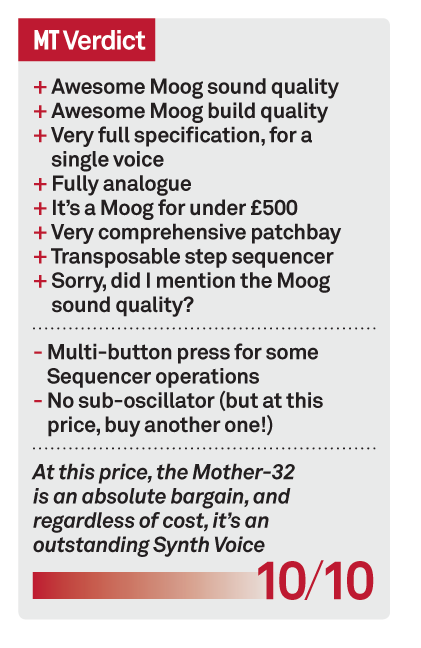
Key Features
● Semi-modular monophonic analogue synthesiser
● Inbuilt 32-step sequencer
● Conforms to Eurorack format or desktop/standalone
● Width – 60 HP
● Comes mounted in its own desktop case, with power and MIDI
● Current draw – 230mA
● CV/Gate inputs and MIDI are both available